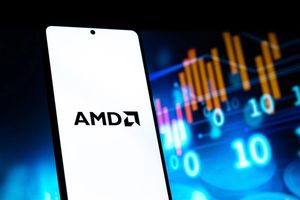
Samsung Electronics (KRX: 005930), a global titan in the technology industry, finds itself at a pivotal juncture in 2025. While its mobile division continues to demonstrate robust performance, particularly with the surging demand for foldable smartphones and aggressive AI integration, the semiconductor arm is grappling with significant headwinds. Intense competition in the high-bandwidth memory (HBM) sector, challenges in its foundry business, and revised-down earnings forecasts cast a cautious shadow over the company's otherwise strong market presence.
The dual narrative of success and struggle defines Samsung's current investor outlook. With analysts maintaining a "Buy" consensus despite acknowledging near-term challenges, the coming months will be critical in determining whether the company's strategic pivots in AI and high-value memory products can overcome the persistent pressures in its core semiconductor business and drive the anticipated rebound in the latter half of the year.
Samsung's Mixed Fortunes: Mobile Soars as Chips Face a Downturn
Samsung Electronics (KRX: 005930) continues to be a dominant force in the global electronics market, maintaining its standing as a top-tier technology company. However, 2025 has presented a nuanced picture of its performance, characterized by contrasting fortunes within its diverse portfolio. The mobile division has largely been a beacon of strength, while the semiconductor division has encountered a more challenging environment.
In the first quarter of 2025, Samsung reaffirmed its leadership in the global smartphone market, outperforming competitors like Apple with 60.5 million units shipped and capturing a 20% market share. This robust performance is largely attributed to its innovative push into foldable smartphones, with models like the Galaxy Z Fold 7 and Z Flip 7 generating significant consumer interest and driving growth. Furthermore, Samsung's aggressive integration of AI features across its premium and mid-tier Galaxy series, including the A36 and A56, is expected to bolster sales and potentially influence future device replacement cycles. The mid-range A-series models, performing strongly in key markets like the U.S., are projected to account for a substantial 40% of the company's mobile sales in 2025.
Conversely, the semiconductor division, traditionally a cornerstone of Samsung's profitability, has faced a tougher landscape. Despite its strong leadership in the global memory market, the company is battling intensifying competition, particularly in the advanced AI chip segment. Profitability issues within its foundry division, coupled with delays in securing major contracts and a potential pushback in the opening of its U.S. factory to 2027, have raised concerns. Samsung is also actively striving to narrow the gap with rivals like SK Hynix in the crucial HBM chip market, a vital component for AI applications. The initial half of 2025 has seen a downturn in the semiconductor business, marked by weak AI chip demand and a decline in DRAM and NAND flash chip prices, prompting several leading South Korean brokerage firms to sharply downgrade Samsung's 2025 operating profit forecasts by over 36%. These revised estimates, now around 40.48 trillion won, highlight the significant pressure on this critical segment.
Shifting Sands: Who Wins and Who Loses in Samsung's Ecosystem
The current market dynamics for Samsung Electronics (KRX: 005930) create a complex web of winners and losers, both within its own sprawling empire and across the broader technology landscape. Internally, the stark contrast between the mobile and semiconductor divisions defines the immediate winners and those facing significant challenges. Externally, competitors are either capitalizing on Samsung's struggles or being pushed to innovate further.
Within Samsung, the Mobile eXperience (MX) division stands out as a clear winner. Its strategic focus on foldable technology, exemplified by the highly anticipated Galaxy Z Fold 7, and the proactive integration of on-device AI capabilities have resonated strongly with consumers and analysts alike. This division's ability to maintain market leadership and drive innovation in premium segments is providing a crucial counterweight to the difficulties faced elsewhere. The success of the mid-range Galaxy A-series also signifies a winning strategy in capturing broader market share, particularly in emerging markets, ensuring diversified revenue streams and continued brand loyalty.
On the other hand, Samsung's Device Solutions (DS) division, encompassing its semiconductor and display businesses, faces a more challenging outlook, particularly the foundry and memory sub-segments. While the long-term demand for AI-driven memory is robust, the short-term competitive landscape, especially in HBM, presents significant hurdles. Samsung has lagged behind rivals like SK Hynix (KRX: 000660) in securing major HBM orders from key AI players such as Nvidia (NASDAQ: NVDA), leading to a perception of being a 'loser' in this critical, high-growth area. The unprofitability of its foundry operations and delays in expanding its U.S. manufacturing capabilities further amplify these challenges, impacting investor confidence and contributing to the overall downward revision of earnings forecasts.
Externally, competitors in the HBM market like SK Hynix (KRX: 000660) are significant winners, having secured an early lead and strong partnerships with AI giants. This gives them a strategic advantage in a booming market. In the mobile space, Chinese manufacturers such as Huawei, Xiaomi (HKEX: 1810), Oppo, and Vivo continue to gain ground, particularly in the mid-range and even premium foldable segments, posing a threat to Samsung's market share. Huawei (SHE: 002502), for instance, has notably led in foldable market share in Q2 2025, signaling increased competitive pressure. However, the overall robust performance of Samsung's mobile division, driven by innovation, ensures that Apple (NASDAQ: AAPL) still faces a formidable rival in the premium smartphone segment, forcing continuous innovation from both sides.
Industry Shifts and Broader Implications: A Semiconductor Crossroads
Samsung's current trajectory in 2025 is not merely an isolated corporate narrative but a microcosm of broader industry shifts, particularly within the dynamic semiconductor and mobile technology sectors. Its challenges and successes highlight fundamental trends, competitive pressures, and potential ripple effects that will shape the global tech landscape for years to come.
The intense competition in the High-Bandwidth Memory (HBM) market underscores the critical importance of AI in driving the next wave of technological innovation. Samsung's efforts to catch up to SK Hynix (KRX: 000660) in HBM supply demonstrate that leadership in cutting-edge memory is paramount for securing partnerships with AI powerhouses like Nvidia (NASDAQ: NVDA). This race reflects a broader industry trend where specialized, high-performance memory is becoming as crucial as the processing units themselves for advanced AI computing. The delays in Samsung's 12-layer HBM3E supply until after Q3 2025 could impact its ability to fully capitalize on the immediate AI boom, giving rivals a window to solidify their market positions and potentially influence future supply chain dynamics.
In the foundry business, Samsung's struggles and the projected delay in its U.S. factory opening to 2027 point to the immense capital intensity and technical challenges involved in advanced chip manufacturing. This situation reflects a wider trend towards onshoring semiconductor production, driven by geopolitical considerations and the desire for greater supply chain resilience. However, as Samsung's experience shows, building and scaling cutting-edge fabs is a complex, long-term endeavor that requires significant investment and flawless execution. Any missteps can have substantial financial and strategic repercussions, impacting not only the company but also the governments and industries relying on these advanced manufacturing capabilities.
The continued dominance and innovation in Samsung's mobile division, especially with foldable phones and pervasive AI integration, signals a maturation and diversification of the smartphone market. While overall smartphone growth may be slowing, premium segments driven by form factor innovation and intelligent features are creating new avenues for expansion. This trend encourages other manufacturers to invest heavily in R&D for novel designs and AI capabilities, fostering a more competitive and innovative mobile ecosystem. However, it also means increased pressure on companies to differentiate beyond specifications, with user experience and AI functionality becoming key battlegrounds. Geopolitical tensions, particularly regarding tariffs on semiconductor-inclusive products, also pose significant risks, potentially disrupting global supply chains and increasing costs for all players, including Samsung, which has extensive manufacturing and sales operations worldwide.
What Comes Next: Navigating the Future of Tech Leadership
Samsung Electronics (KRX: 005930) stands at a critical juncture in 2025, with its strategic decisions in the coming months poised to define its trajectory for the latter half of the decade. The interplay of product launches, competitive responses, and its ability to execute on its AI vision will be paramount in shaping its short-term performance and long-term market leadership.
In the immediate future, the performance of upcoming product launches, most notably the Galaxy Z Fold 7, will be a key indicator of the mobile division's continued strength. Strong sales and positive market reception for its latest foldables and AI-powered smartphones are crucial for maintaining momentum and offsetting the challenges in the semiconductor segment. Investors will be closely watching for robust adoption rates and any signs that Samsung's AI-driven features are genuinely resonating with consumers, potentially driving an upgrade cycle in 2026. The company's ability to seamlessly integrate AI across its device ecosystem, from premium to mid-range models, will be central to its competitive differentiation against rivals like Apple (NASDAQ: AAPL) and Chinese manufacturers.
For the semiconductor division, overcoming the current headwinds in the HBM and foundry markets is a top priority. Samsung needs to provide a clearer roadmap for its HBM business, demonstrating how it plans to accelerate production and secure key client contracts to catch up with rivals such as SK Hynix (KRX: 000660). Successful execution of its 2-nanometer process in the foundry business and the timely, profitable scaling of its advanced manufacturing facilities will be vital for regaining investor confidence and securing future chip orders. The company's renewed emphasis on high-value memory products and AI advancements across all its business segments represents a strategic pivot aimed at leveraging future demand.
Analyst ratings and price targets, which currently average around KRW 83,816.43, suggest a potential upside of approximately 17% from current levels. However, these projections are heavily reliant on Samsung's ability to execute on its stated strategies. Investors will be looking for tangible improvements in its key financial metrics, particularly a recovery in semiconductor profitability and stronger-than-expected revenue growth from its AI-focused initiatives. Any strategic pivots, such as potential M&A activities to bolster its AI capabilities or secure crucial memory IP, could also significantly impact market perception and future prospects.
Conclusion: A Tech Giant's Defining Moment
Samsung Electronics (KRX: 005930) is navigating a defining period in 2025, characterized by a sharp contrast between the resounding success of its mobile division and the persistent challenges within its semiconductor business. The company's strategic foresight in foldables and AI integration has cemented its mobile leadership, yet its efforts to catch up in the fiercely competitive HBM market and stabilize its foundry operations remain critical tests. This dual narrative encapsulates the dynamic and often unpredictable nature of the global technology landscape.
Looking ahead, Samsung's ability to realize the anticipated rebound in the latter half of 2025 hinges significantly on its execution in the semiconductor space. The market will closely monitor its progress in scaling HBM production, securing new foundry clients, and translating its aggressive AI investments into tangible revenue growth and improved profitability. While analyst sentiment remains largely positive, with significant upside potential in stock price targets, these projections are underpinned by an expectation of strategic acumen and operational excellence.
For investors, the coming months will be a period of intense scrutiny. Key takeaways include the robust health of Samsung's mobile segment, driven by innovation, but also the pressing need for a clear and effective strategy to overcome semiconductor headwinds. The significance of Samsung's trajectory extends beyond its own balance sheet, impacting the broader AI ecosystem, global supply chains for advanced chips, and the competitive dynamics of the consumer electronics market. The ultimate outcome will reveal whether this tech giant can successfully pivot its vast resources to not only weather the current storm but also emerge stronger, solidifying its position at the forefront of the next era of technological advancement.






